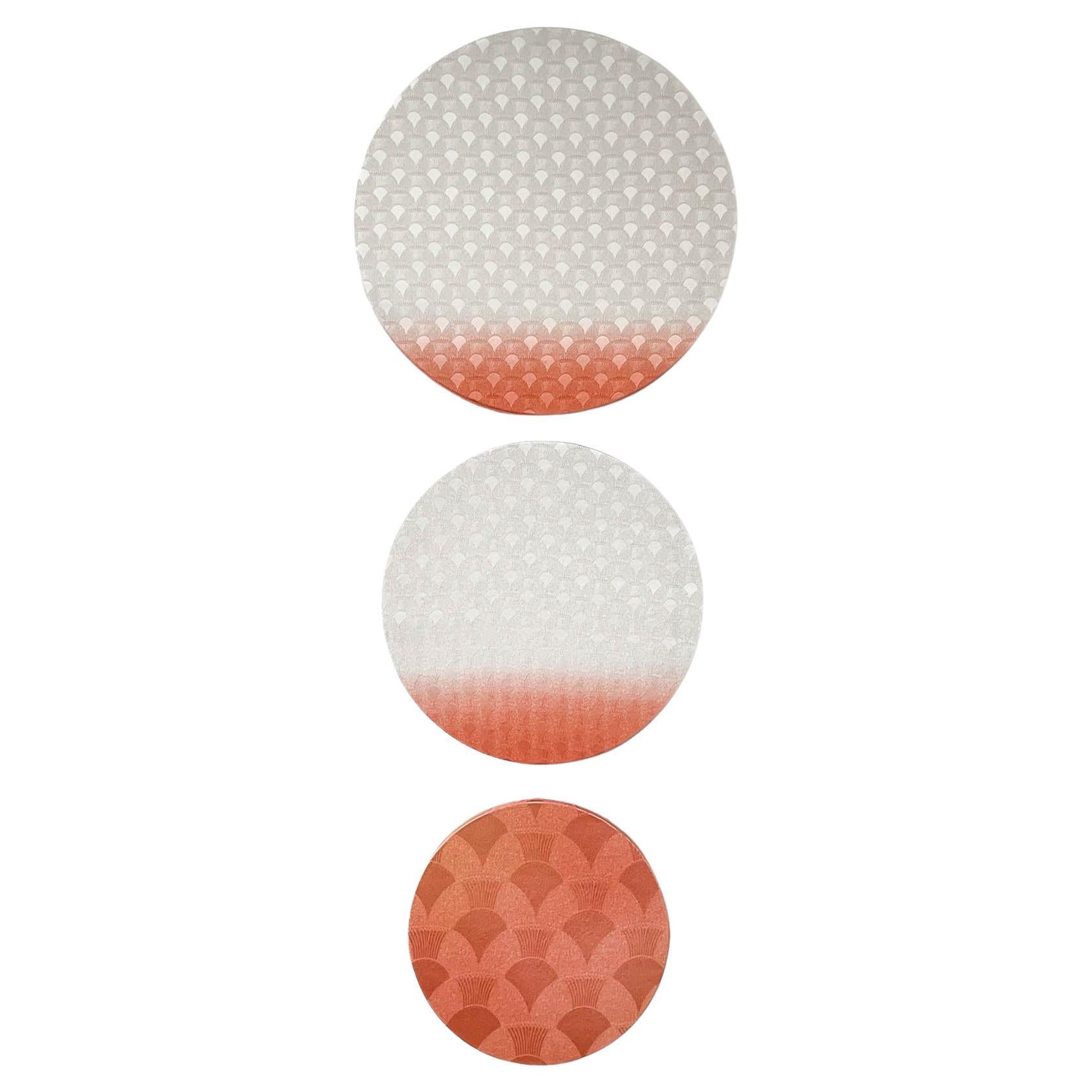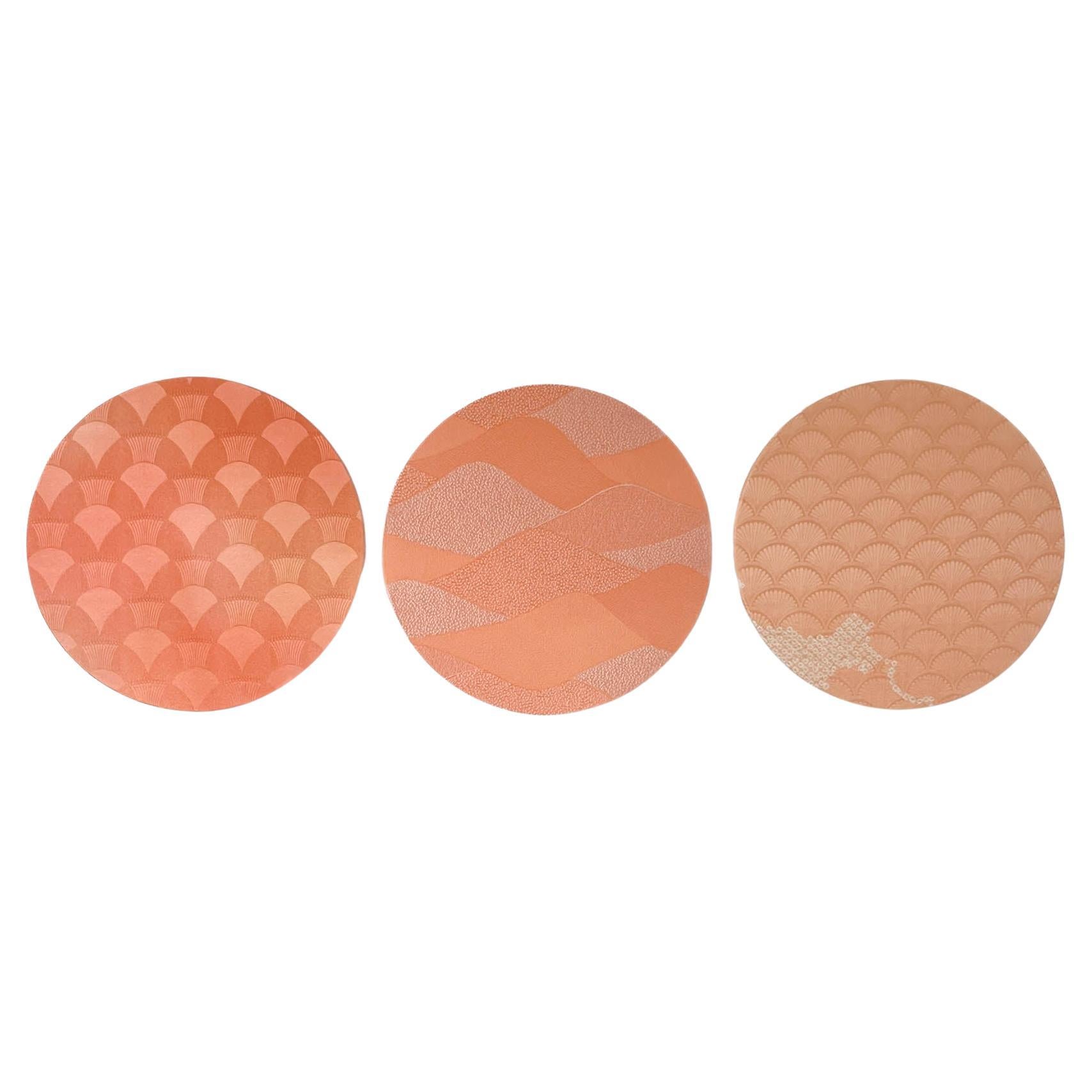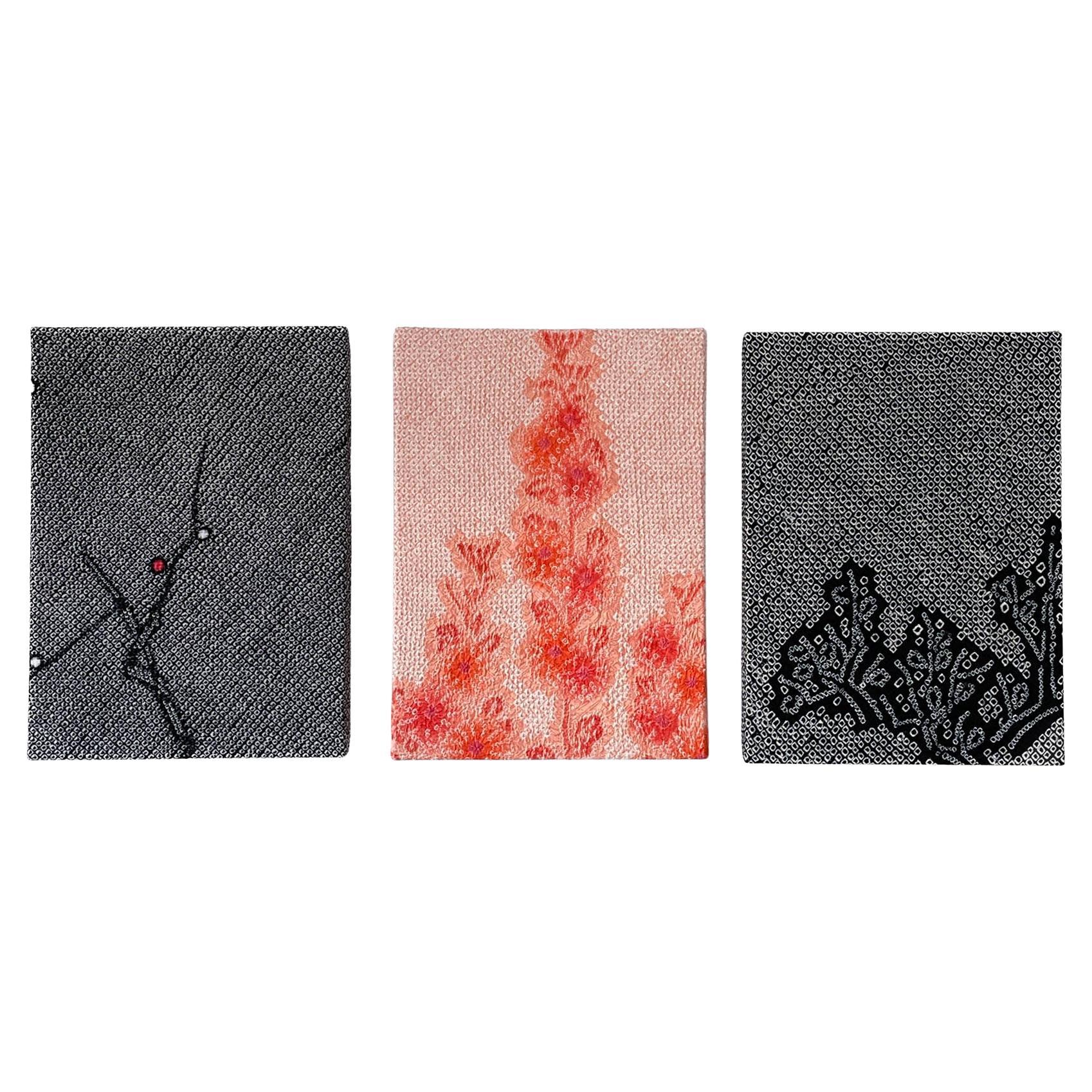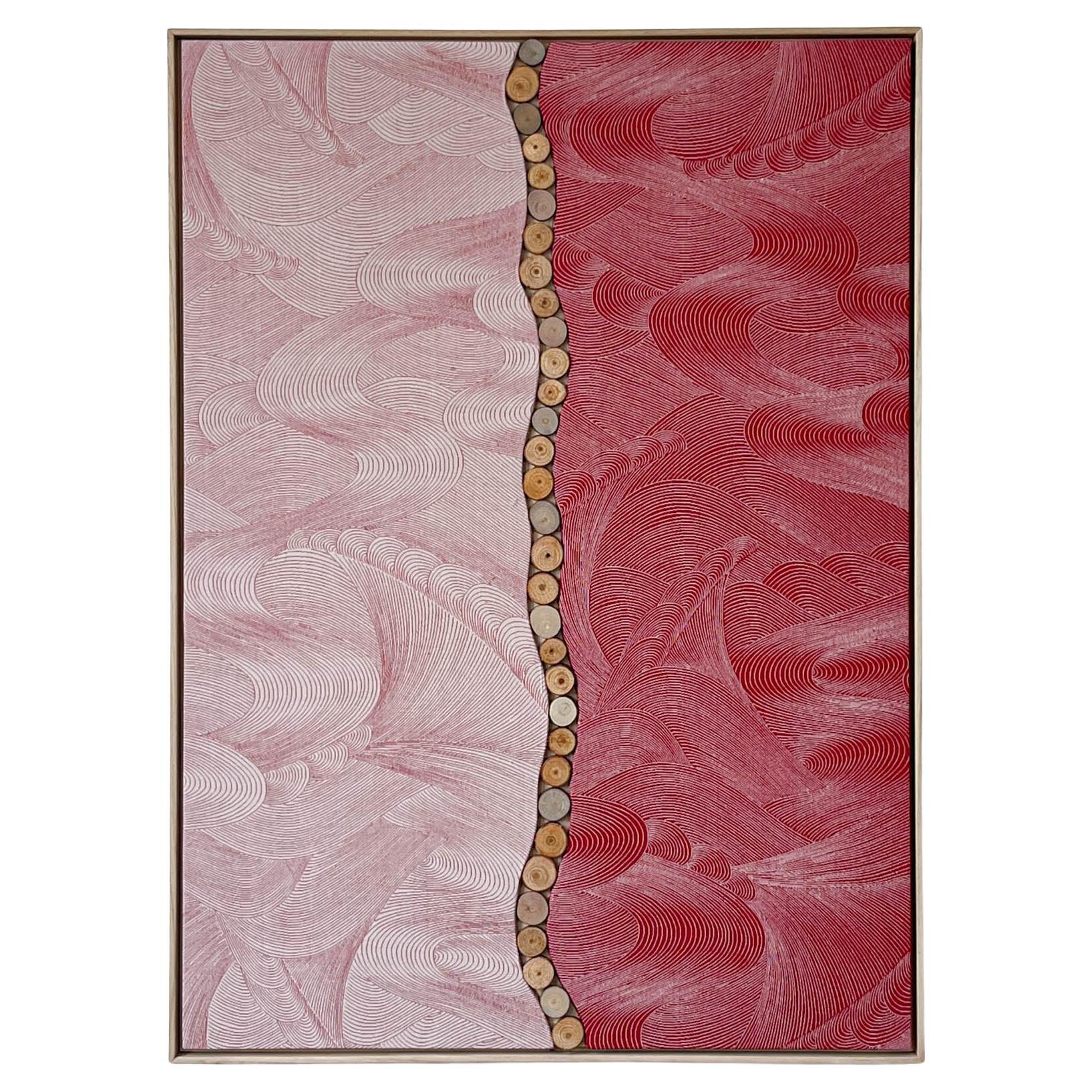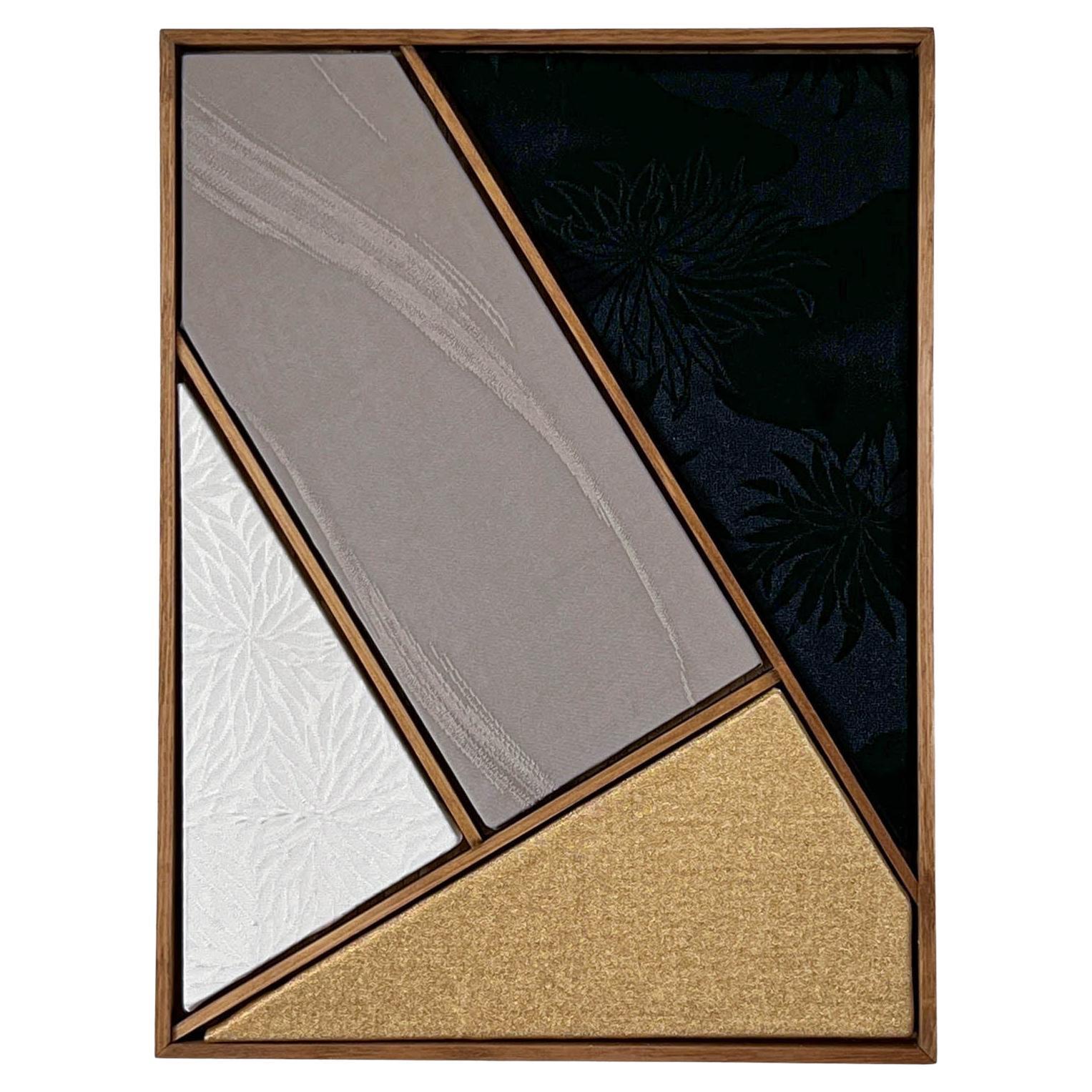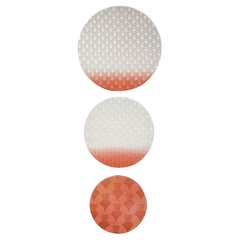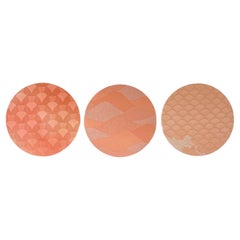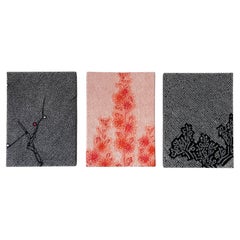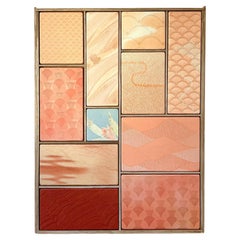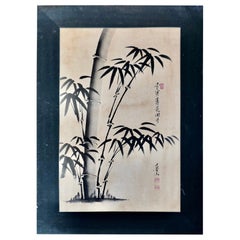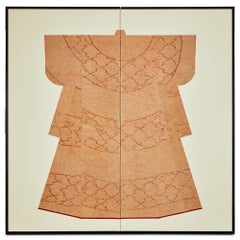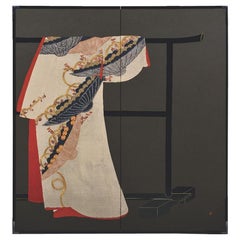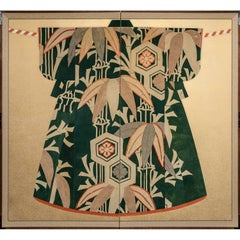Items Similar to Vintage kimono textile art " Growing ~ Longevity ~ " by ikasu Pink, Japan
Want more images or videos?
Request additional images or videos from the seller
1 of 21
Vintage kimono textile art " Growing ~ Longevity ~ " by ikasu Pink, Japan
About the Item
<< About this canvas >>
This set is a depiction of a tall chrysanthemum stem, entirely dyed in a traditional shibori technique.
<< Period / Story >>
The haori featured in this canvas was created and used during the late Showa period (1960-80ies).
<< Explanation and meaning of pattern and colors >>
A charming chrysanthemum flowers all around a stem seem to reach the heavens.
The chrysanthemum flower, which retains its vitality long after being cut, symbolizes longevity, purification from malevolent spirits, and good fortune. In ancient times, during the Kamakura period (1185-1333), emperors loved the chrysanthemum pattern, and it remains the most prestigious flower and the emblem of the Japanese imperial family to this day.
The entire artwork is dyed in a gentle vermilion hue. Vermilion, also known as "shu-iro," is a vibrant red shade with yellow undertones. In the past, the finest red pigment was referred to as "shu-iro."
Vermilion also carries the symbolism of authoritative power, and it is said that when ancient tombs are excavated, vermilion is often found alongside the remains of nobility. Beyond its historical significance, vermilion holds various other meanings, such as the warmth of fire, the brilliance of the sun, protection against malevolent forces, prevention of misfortune, the blessing of offspring, and fertility.
<< Characteristics of the fabric >>
The kimono fabrics in this set are all meticulously dyed using a tie-dyeing technique known as "soshibori," which has been practiced in Japan since the 6th to 7th century.
In this intricate process, the fabric is bound using threads, boards, and specialized tools to create areas where the dye cannot penetrate. Once the entire cloth is dyed, the threads are carefully untied, leaving behind the bound areas untouched. As a result, the colors emerge in a three-dimensional textures, forming intricate patterns.
Because tie-dyeing is a labor-intensive, handcrafted method, only a limited number of pieces, ranging from a few hundred to a few thousand, can be produced in a day. It's worth noting that this process can take several months to a year or even longer to complete, as more than 200,000 knots need to be tied for a single kimono.
The "Kanoko shibori" applied to the entire fabric of this haori is a particular type of so-called "fawn" shibori, known for its resemblance to the spots on a young deer, which adds to its unique and appealing appearance.
- Creator:Kimono ikasu (Artist)
- Dimensions:Height: 31.5 in (80 cm)Width: 13.39 in (34 cm)Depth: 0.79 in (2 cm)
- Style:Japonisme (In the Style Of)
- Materials and Techniques:
- Place of Origin:
- Period:
- Date of Manufacture:1970ies
- Condition:
- Seller Location:Setagaya City, JP
- Reference Number:1stDibs: LU10079243699182
About the Seller
New to 1stDibs
Joined in the past six months.
No Reviews Yet
Vetted Professional Seller
Every seller passes strict standards for authenticity and reliability
1stDibs seller since 2024
- ShippingRetrieving quote...Shipping from: Setagaya City, Japan
- Return Policy
Authenticity Guarantee
In the unlikely event there’s an issue with an item’s authenticity, contact us within 1 year for a full refund. DetailsMoney-Back Guarantee
If your item is not as described, is damaged in transit, or does not arrive, contact us within 7 days for a full refund. Details24-Hour Cancellation
You have a 24-hour grace period in which to reconsider your purchase, with no questions asked.Vetted Professional Sellers
Our world-class sellers must adhere to strict standards for service and quality, maintaining the integrity of our listings.Price-Match Guarantee
If you find that a seller listed the same item for a lower price elsewhere, we’ll match it.Trusted Global Delivery
Our best-in-class carrier network provides specialized shipping options worldwide, including custom delivery.More From This Seller
View AllVintage kimono textile art " Plum Gradation " by ikasu Pink, White, Japan
By Kimono ikasu
Located in Setagaya City, JP
This canvas featuring a plum color gradient kimono showcases a unique decorative variation of the popular seigaiha (青海波) sea waves pattern.
The artwork got a Mr. & Mrs. Abe Arts & Cu...
Category
Vintage 1980s Japanese Japonisme Paintings and Screens
Materials
Canvas, Silk
Vintage kimono textile art "On Coral Waves ~Everlasting~" by ikasu Pink, Japan
By Kimono ikasu
Located in Setagaya City, JP
<< About this canvas >>
This kimono canvas set of three pieces portrays mountains surrounded by the sea. While each of the three pieces is crafted from different kimonos, they all s...
Category
Vintage 1970s Japanese Japonisme Paintings and Screens
Materials
Silk, Canvas
Vintage kimono textile art "Flowers ~Life Circle~" by ikasu Pink, Black, Japan
By Kimono ikasu
Located in Setagaya City, JP
<< About this canvas >>
This canvas is crafted from three different haori fabrics, each adorned with a shibori dyeing flower motif going through entire fabric. These fabrics tell a ...
Category
Vintage 1970s Japanese Japonisme Paintings and Screens
Materials
Canvas, Silk
Antique kimono textile art " Kobachi ~ Coral Collection ~ " by ikasu Pink, Japan
By Kimono ikasu
Located in Setagaya City, JP
This work is inspired by the coral color palette, and is framed in paulownia wood originally used for a kimono chest-of-drawers.
In this artwork, the aim was to capture the wide pal...
Category
Vintage 1920s Japanese Japonisme Paintings and Screens
Materials
Silk, Wood
Vintage kimono textile art "Sunset Timelapse ~Ephemerality~" by ikasu Red, Japan
By Kimono ikasu
Located in Setagaya City, JP
The art piece uses two sides - front and reverse - of the same kimono, to show beautiful sea surrounding Japan, in hues and in late sunset, as a timelapse.
The frame for this work is made of paulownia wood taken from antique Kiritansu - chest-of-drawers for kimono.
I use antique kiritansu that can’t be used as furniture anymore to create basis and frames for my works. It adds them even more authentic atmosphere of traditional wabisabi spirit. Can you feel it?
<< Period / Story >>
The kimono used in this piece was originally crafted during Showa period (around 1960ies).
<< Explanation and meaning of pattern and colors >>
Sea waves, depicted in two color variations here, are a symbol of transience and Impermanence in Japanese culture. The ebb and flow of the tides, the ever-changing currents, and the relentless motion of the waves serve as reminders of the fleeting nature of life. This artwork featuring the sea convey themes of impermanence, reminding viewers to cherish the present moment and appreciate the beauty of life's fleeting moments.
The theme of impermanence is strengthen by two colors of the sea - the lighter in early hues and the darker when the sun is just about to set in the sea.
<< About the frame >>
This artwork frame is crafted from paulownia wood, a uniquely Japanese material closely tied to the world of kimonos, and it serves to convey the refined beauty of Japanese nature.
Paulownia wood is known as the lightest wood in Japan, prased for its natural luster, resistance to moisture, and resilience against cracking. Since ancient times, it has been used in crafting furniture, chests, and musical instruments.
Paulownia wood is closely linked to kimono culture. During the Edo period (17th cent.~), it became customary to store cherished kimonos in paulownia chests...
Category
Vintage 1960s Japanese Japonisme Paintings and Screens
Materials
Silk, Wood
VIntage kimono textile art " Monochrome Geometry " by ikasu Gold, Grey, Japan
By Kimono ikasu
Located in Setagaya City, JP
This work is inspired by traditional Japanese nature colors symbolism, and is framed in paulownia wood originally used for a kimono chest-of-drawers.
It is filled with storytelling ...
Category
Vintage 1960s Japanese Japonisme Paintings and Screens
Materials
Silk, Wood
You May Also Like
Vintage Bamboo Japanese Art, Wall Art 5 excellent pieces
Located in Chillerton, Isle of Wight
Vintage Bamboo Japanese Art, Wall Art
5 excellent pieces, on cartridge paper set on Black Silk
Wonderful Vintage pieces, from 1980, 21.5” high, 15.5” wide
ZX281
Category
Vintage 1980s Japonisme Paintings and Screens
Materials
Paper
Japanese Two Panel Screen: Kimono
Located in Hudson, NY
Beautiful 19th century shibori (pin dyed) fabric in kimono form mounted on a simple ground of mulberry paper. Black lacquer trim with beautifully designed bronze mounts. The fabric ...
Category
Early 20th Century Paintings and Screens
Materials
Fabric, Wood, Lacquer, Paper
Japanese Contemporary Red Black Cream Folding Screen Silk Brocade Kimono Art, 3
Located in Takarazuka, JP
Exceptional Japanese contemporary two panel "byobu" or folding screen featuring genryoku style handcrafted silk raised kimono Japanese decorative art in crimson red, black and gold o...
Category
21st Century and Contemporary Japanese Meiji Paintings and Screens
Materials
Gold
Japanese Two Panel Screen: Antique Kimono Fabric Mounted on Screen
Located in Hudson, NY
Japanese Two Panel Screen: Late Nineteenth Century Kimono Fabric Mounted on Early Twentieth Century Screen. In the Heian period (eighth century to the twelfth century), noblemen wou...
Category
Early 20th Century Japanese Meiji Paintings and Screens
Materials
Silk, Wood, Paper
Chinese Floral Longevity Canopy Painting, c. 1900
Located in Chicago, IL
Thoughts of a long, happy life greeted the young couple who gazed up from their bed on this canopy panel. Adorned with chrysanthemums and peaches, both symbols of longevity, the lyri...
Category
Early 20th Century Chinese Qing Paintings and Screens
Materials
Pine, Paint
Japanese Two Panel Screen Geometric Design on Mounted Textile
Located in Hudson, NY
In strong primary colors. Makers seal reads: Yu.
Category
Mid-20th Century Japanese Paintings and Screens
Materials
Paint
Recently Viewed
View AllMore Ways To Browse
Pink Vintage Furniture
Japanese Kimono
Japanese Used Kimono
Vintage Fabric Screen
Chrysanthemum Pattern
Vintage Japanese Hand Painted
Vintage Kimonos
Red Kimono
Vintage Japanese Tools
Fire Screen Vintage
Vintage Fire Screen Screens
Fire Screens Painted
Hand Painted Ties Vintage
Vintage Sun Shade
Shibori
Vintage Kimono Japan
Pink Chrysanthemum
Fawn Vintage
